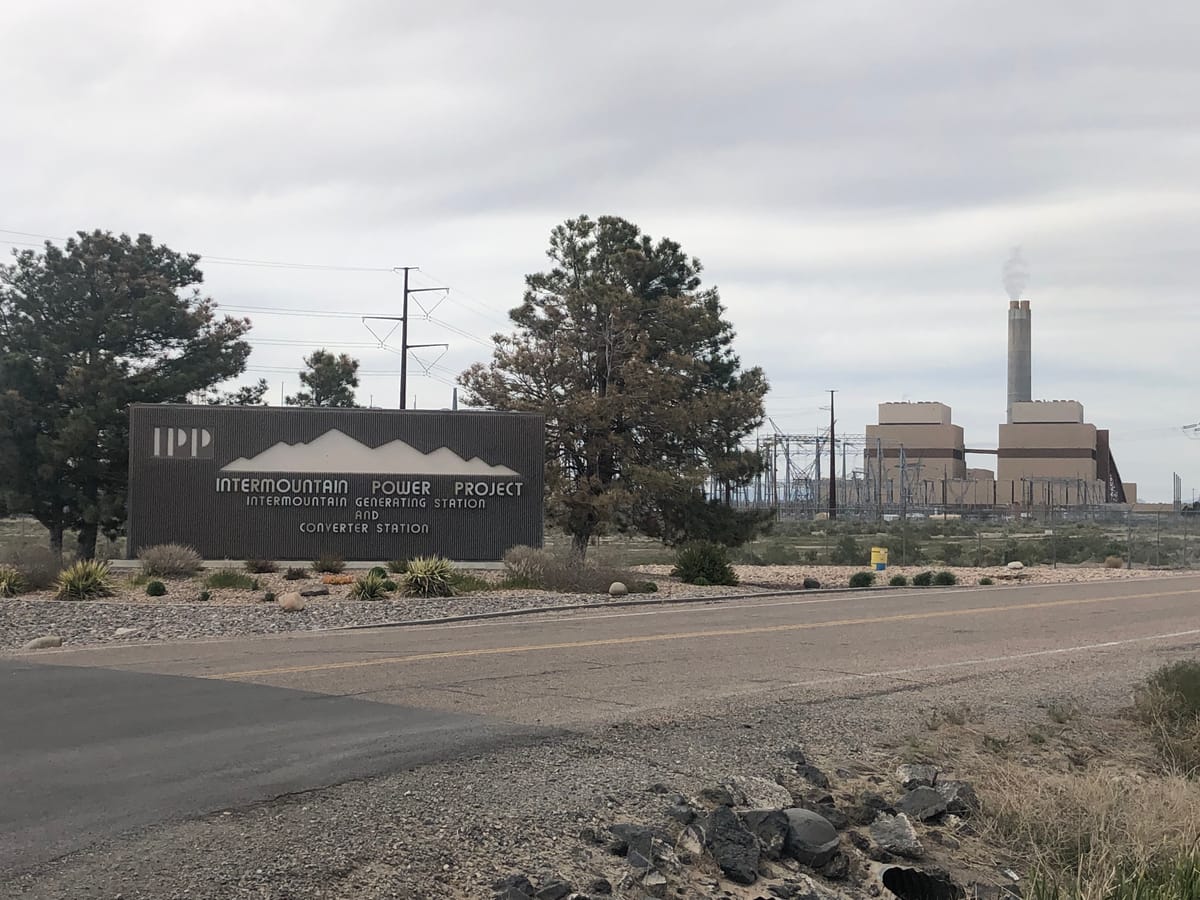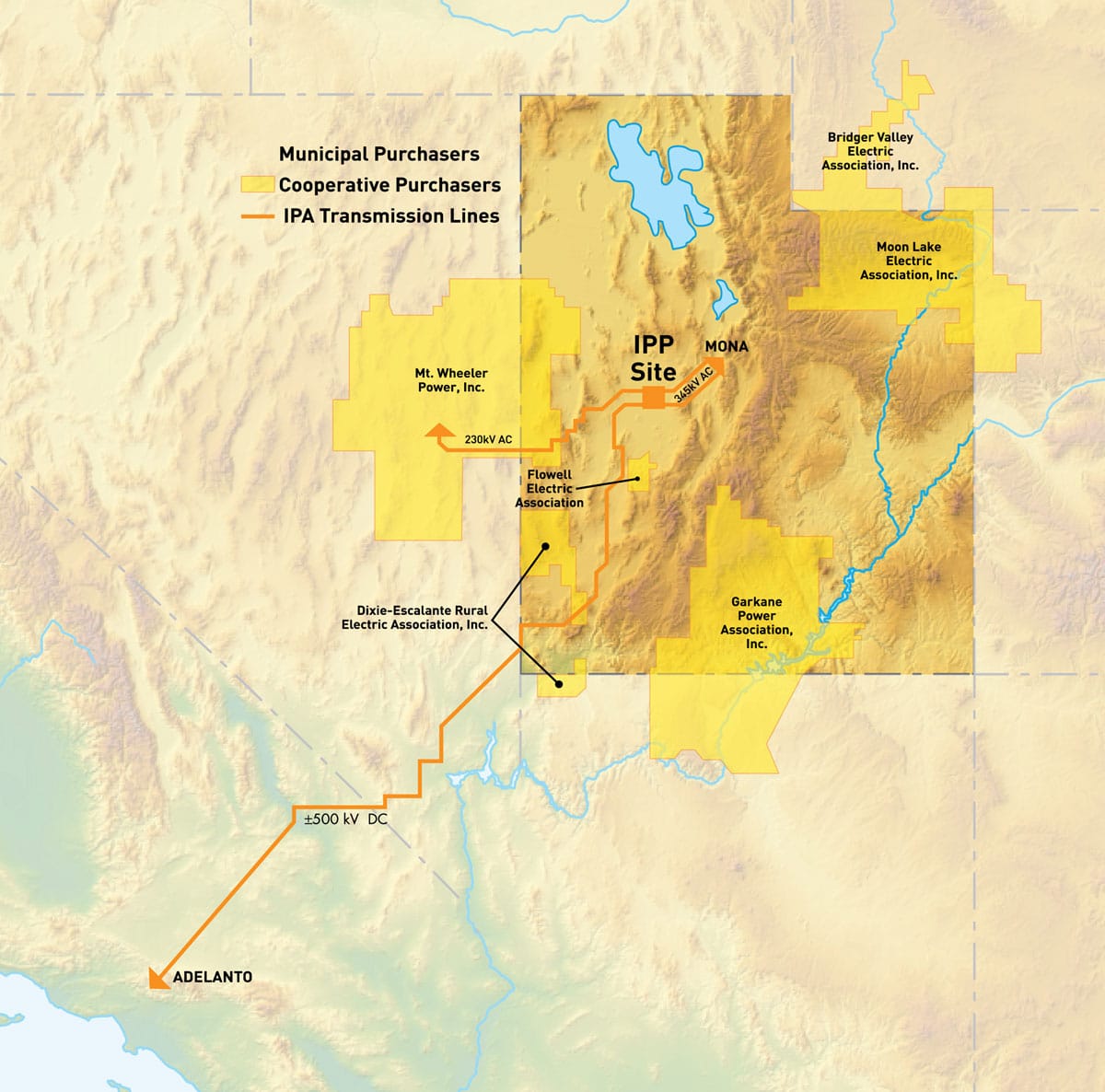Utah's IPA is Issuing Two Bonds to Raise ~$115 Million to Install Two Gas-Fired Turbines in Place of Two Coal-Fired Turbines at its Intermountain Power Project Facilities in Delta, Utah

Utah's Intermountain Power Agency, owner of the electricity-generating IPP (Intermountain Power Project) located just north of Delta, Utah in Millard County, provides over 13 million megawatt hours of electricity annually (1,300 Gigawatts) to 35 customers (23 municipalities in Utah and six in California), plus 6 cooperative purchasers in rural portions of Arizona, Colorado, Nevada, Utah, and Wyoming.
The IPA plans to raise $114.6 million via two tax-exempt Power Supply Revenue Bonds to replace two coal-fired turbines with two natural gas burning turbines.
The South Jordan, Utah-headquartered Intermountain Power Agency has announced plans to raise $114.6 million via two tax-exempt Power Supply Revenue Bonds to fund the replacement of two coal-fired turbines with two turbines that burn natural gas to produce electricity.
According to the preliminary IPA bond offering (as published by MuniOS), with the bond monies, the IPA will replace two coal-powered turbines at its electricity-generating plant just north of Delta, Utah in Millard County, an entity now known as the Intermountain Power Project.
Lead underwriters for these two bonds are Goldman Sachs and RBC Capital Markets, with the formal offering expected sometime in November 2024.
The IPA was formed in mid-1997 as "... a separate legal entity and a political subdivision of the State of Utah ..."
Through the Intermountain Power Project, the IPA currently produces over 13 million megawatt hours of energy annually (or 1,300 gigawatt hours) which it provides to 35 different customers, with the amount of electricity each entity draws from IPP's annual production shown in parentheses below.
6 Utah Cooperative Purchasers
- Bridger Valley Electric Association (0.230%),
- Dixie-Escalante Rural Electric Association (1.534%),
- Flowell Electric Association (0.200%),
- Garkane Power Association (1.267%),
- Moon Lake Electric Association (2.000%), and
- Mt. Wheeler Power (1.786%),
for a total of 7.017% of the electricity produced annually by the IPA.

23 Municipalities in Utah (each of which own electric utilities)
- Beaver (0.413%),
- Bountiful (1.695%),
- Enterprise (0.199%),
- Ephraim 0.503%),
- Fairview (0.120%),
- Fillmore (0.512%),
- Heber (0.627%),
- Holden (0.048%),
- Hurricane (0.147%),
- Hyrum (0.551%),
- Kanosh (0.040%),
- Kaysville (0.739%),
- Lehi (0.430%),
- Logan (2.469%),
- Meadow (0.045%),
- Monroe (0.130%),
- Morgan (0.190%),
- Mount Pleasant (0.357%),
- Murray (4.000%),
- Oak City (0.040%),
- Parowan (0.364%), and
- Spring City (0.060%),
for a total of 14.040% of the power produced each year by the IPA.
6 Municipalities in California
- Anaheim (13.225%),
- Burbank (3.371%),
- Glendale (1.704%),
- Los Angeles (48.617%),
- Pasadena (4.409%), and
- Riverside (7.617%),
for a total of 78.943% of the electricity produced annually by the IPA.
Author's Note
The Intermountain Power Agency began work in 2022 on what is named IPP Renewed, a new energy-producing endeavor designed to eventually move to creating energy by exclusively burning so-called Green Hydrogen, hydrogen created and stored on-site via electrolysis.
Through this process, IPA will use excess electricity to separate water into hydrogen and oxygen, with the the hydrogen it produces stored below ground in naturally occurring salt caverns, the only such geologic formation known to exist in the United States not adjacent to an ocean.
And because no carbon or carbon byproducts are produced in this process, the hydrogen released by the electrolysis is considered Green Hydrogen.
When this Green Hydrogen is then burned to create electricity, a byproduct is water, H2O, which can then be burned via electrolysis to begin the process once again.
According to the IPP Renewed website, when its new gas-burning facility comes online in 2025, 30% of the gasses burned onsite will be Green Hydrogen with the remaining 70% being natural gas.
Additionally, the IPP Renewed website also explains that electrolysis will actually use less water than is currently required in the current IPP facilities.
The transition to a 100% Green Hydrogen facility will take place by 2045.
For those interested, the YouTube video below provides a straightforward, four-and-a-half-minute overview of IPP Renewed.
IPP Renewed update video downloaded 29 October 2024 from YouTube.
Publisher's Note
Are you interested in timely Utah-focused monetary, financial, and/or business news, context, and analysis, content NOT currently available through any other source?
Then you should become a subscriber to Utah Money Watch. Today!
Simply,
1. Click on a "Subscribe" button on any Utah Money Watch webpage,
2. Enter in your name in the proper field in the popup window that appears on-screen, and
3. Enter your preferred email address in the proper field too.
That's it. And "Yes," it really is that simple.
And it IS free ... for now, at least.
So we hope to see you join us as a subscriber of Utah Money Watch.
Thanks.
Team Utah Money Watch
P.S. For context, the purpose of Utah Money Watch is to publish news, information, context, and analysis NOT available through any other source.
[You might think of us as the inverse of Bloomberg, CNBC, and/or The Wall Street Journal. In other words, we are passionately focused on uncovering the most important monetary, financial, and/or business news and information that impact the organizations and people of Utah first, followed by regional news/info second, and national/international info/news last of all.]
To that end, this article/report was originally published and distributed to our Subscribers at approximately 8:10am (MT) on Wednesday, 30 October 2024.
However, if this report/article came to your attention sometime after this date/time and you'd like to change that, then to become a subscriber, please follow the steps above.
Thx. DLP




Comments ()